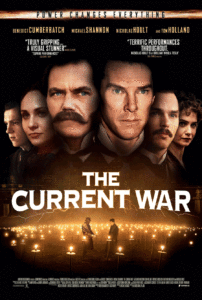Film Review: The Current War
By Deneb Sumbul | Cinema | Published 6 years ago
 Inspired by true events, the film, The Current War, is a historical epic that chronicles the first and one of the greatest full-blown industrial feuds that took place from 1880 to 1893 between two visionary American pioneers of electricity. In the race to introduce electricity to the populace, it was this cut-throat rivalry that eventually electrified the world and ushered in the modern age.
Inspired by true events, the film, The Current War, is a historical epic that chronicles the first and one of the greatest full-blown industrial feuds that took place from 1880 to 1893 between two visionary American pioneers of electricity. In the race to introduce electricity to the populace, it was this cut-throat rivalry that eventually electrified the world and ushered in the modern age.
The film unfolds against the backdrop of 1880, after Thomas Alva Edison (Benedict Cumberbatch) has invented the electric bulb – but what use is a bulb without power or electricity to light it for widespread use? At the time the most popular method of outdoor and indoor lighting in the cities and suburbs was gaslight. The celebrity, cash-strapped inventor successfully tests his radical new Direct Current (DC) technology within one square mile of Manhattan. However, he is too arrogant to recognise or admit that his use of direct current is less efficient than the Alternating Current (AC) system proposed by the charismatic electrical engineer-cum-entrepreneur, George Westinghouse (Michael Shannon), whose railway air brake invention earned him tremendous wealth.
George Westinghouse deduces that Edison’s DC current won’t travel for more than a mile while his own AC idea, that that he puts into motion with his inventor-friend Franklin Poole, can transmit electricity over longer distances and is 75 per cent cheaper. Meanwhile, a third visionary, the Serbian-born genius, Nikola Tesla (Nicholas Hoult), enters the fray and into Edison’s employment. He confirms that Westinghouse’s idea is infinitely more effective to rapidly electrify the entire country.
Westinghouse makes several overtures to Edison to collaborate with their efforts, but is snubbed each time. He forges ahead nevertheless with the Alternating Current system and successfully lights up assorted states in the US, which makes Edison increasingly desperate. Corrupted by his own ambition, Edison uses his celebrity status to malign his competitor in the press, insisting that the alternating current kills, and electrocutes a horse to prove his point.
For a man who vows not to invent anything that would take a human life, Edison is not above crossing ethical lines to become involved in designing the first electric chair, and through an arrangement, credits Westinghouse for it. The fierce rivalry extends to winning the contract to light up the Chicago World Fair of 1893, where the public at large would see electric lights for the first time.
The Current War boasts great performances from Cumberbatch, Shannon and Hoult, who convey the historical figures’ ambitions and struggles with authenticity. Cumberbatch gives a formidable performance, as the prolific, wily Edison, while the film’s other lead, Shannon, gives a subtle, measured portrayal of Westinghouse as an imposing man of quiet determination. Nicholas Hoult, as the very nattily dressed Nikola Tesla, is arguably the most interesting character but he has a very brief screen time that focuses more on his quirks than his visionary scientific achievements.
Directed by Alfonso Gomez-Rejon and produced by Martin Scorsese, the intriguing drama suffered its own tumultuous production history. The film premiered at the Toronto International Film Festival in October 2017 as a project of Weinstein Company and primed as an Oscar contender. In the same month, it became a casualty of the Harvey Weinstein scandal, after the first wave of sexual misconduct allegations were levelled against him. As his company disintegrated, The Current War was withdrawn from release and shelved. Only after it shook off every last one of its Weinstein ties, it was released recently, just in time for the upcoming awards season.
The real history of electricity is far more gripping than what is shown in The Current War. It was strongly rumoured that Edison, in fact, was not the true inventor of the light bulb. Magazines and newspapers in 1893 reported that 25 years earlier, German-born precision mechanic and inventor Henry Goebel had developed the practical incandescent light bulbs, comparable to those invented by Thomas Alva Edison in 1879. In 1893, three manufacturers of the incandescent lamps were sued by the Edison Electric Light Company for infringing Edison’s patent. These companies claimed in their defence, that the Edison patent was void because of the same invention by Göbel 25 years earlier, which came to be known as the “Göbel defence.”
The writer is working with the Newsline as Assistant Editor, she is a documentary filmmaker and activist.


